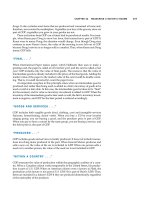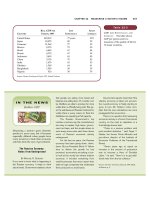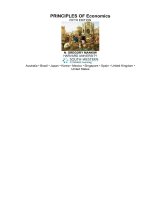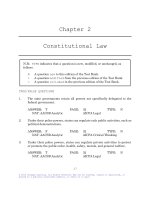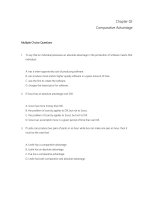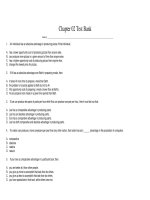Modern principles of economics 2nd edition
Bạn đang xem bản rút gọn của tài liệu. Xem và tải ngay bản đầy đủ của tài liệu tại đây (32.58 MB, 558 trang )
This page intentionally left blank
CTECON-front-end-sheets_Cowen1e_00_IFC Left 11/10/11 4:05 PM Page 1
S E E T H E I N V I S I B L E H A N D . C O M
You’ll be hooked from page 1...
...by the most compelling writing in the
principles of economics market.
C O W E N
•
TA B A R R O K
MODERN PRINCIPLES OF ECONOMICS, SECOND EDITION
CTECON-front-end-sheets_Cowen1e_00_IFC Left 11/10/11 4:05 PM Page 2
C O W E N
•
TA B A R R O K
MODERN PRINCIPLES OF ECONOMICS, SECOND EDITION
S E E T H E I N V I S I B L E H A N D . C O M
When you write this well, you don’t
need boxes to maintain interest…
CTECON-front-end-sheets_Cowen1e_00_IFC Left 11/10/11 4:06 PM Page 3
Beautiful, uncluttered design with
pictures that drive the story…
Economic Growth
Financial System
S E E T H E I N V I S I B L E H A N D . C O M
Wealth of Nations
Investments
C O W E N
International Trade
•
TA B A R R O K
MODERN PRINCIPLES OF ECONOMICS, SECOND EDITION
This page intentionally left blank
MODERN PRINCIPLES OF
ECONOMICS
Cowen2e_Econ_i_HalfTitle.indd i
10/24/11 10:06 AM
this page left intentionally blank
Cowen2e_Econ_i_HalfTitle.indd ii
10/24/11 10:06 AM
MODERN PRINCIPLES OF
ECONOMICS
Second Edition
Tyler Cowen
George Mason University
Alex Tabarrok
George Mason University
Worth Publishers
Cowen2e_Econ_iii_TitlePg.indd iii
10/24/11 10:06 AM
Senior Publisher: Catherine Woods
Executive Editor: Charles Linsmeier
Senior Acquisitions Editor: Sarah Dorger
Executive Marketing Manager: Scott Guile
Consulting Editor: Paul Shensa
Senior Developmental Editor: Bruce Kaplan
Supplements and Media Editor: Tom Acox
Director of Market Research and Development: Steven Rigolosi
Associate Managing Editor: Lisa Kinne
Editorial Assistant: Mary Walsh
Art Director: Babs Reingold
Cover and Text Designer: Kevin Kall
Project Editor: Anthony Calcara
Photo Editor: Christine Buese
Production Manager: Barbara Anne Seixas
Supplements Production Manager: Stacey Alexander
Supplements Project Editor: Edgar Bonilla
Composition: TSI Graphics
Printing and Binding: RR Donnelley
Cover Image: Image Werks/Corbis and Jim Roof/myLoupe.com
Library of Congress Control Number: 2011940683
ISBN-13: 978-1-4292-3997-4
ISBN-10: 1-4292-3997-2
© 2013, 2010 by Worth Publishers
All rights reserved.
Printed in the United States of America
First printing 2011
Worth Publishers
41 Madison Avenue
New York, NY 10010
www.worthpublishers.com
Cowen2e_Econ_iv_CR.indd iv
10/24/11 10:06 AM
Economics is the study of how to get the most out of life.
Tyler and Alex
Cowen2e_Econ_v_DED.indd v
10/24/11 10:06 AM
this page left intentionally blank
Cowen2e_Econ_i_HalfTitle.indd ii
10/24/11 10:06 AM
ABOUT THE AUTHORS
Tyler Cowen (left) is Holbert C. Harris Professor of Economics at George
Mason University. His latest book is The Great Stagnation. With Alex Tabarrok,
he writes an economics blog at www.marginalrevolution.com. He has published
in the American Economic Review, Journal of Political Economy, and many other
economics journals. He also writes regularly for the popular press, including
the New York Times, the Washington Post, Forbes, the Wilson Quarterly, Money
Magazine, and many other outlets.
Alex Tabarrok (right) is Bartley J. Madden Chair in Economics at the
Mercatus Center at George Mason University and director of research
for The Independent Institute. His latest book is Launching the Innovation
Renaissance. His recent research looks at bounty hunters, judicial incentives and elections, crime control, patent reform, methods to increase the
supply of human organs for transplant, and the regulation of pharmaceuticals.
He is the editor of the books Entrepreneurial Economics: Bright Ideas from the
Dismal Science and The Voluntary City: Choice, Community, and Civil Society
among others. His papers have appeared in the Journal of Law and Economics, Public Choice, Economic Inquiry, the Journal of Health Economics, the Journal
of Theoretical Politics, the American Law and Economics Review, and many other
journals. Popular articles have appeared in the New York Times, the Wall Street
Journal, Forbes, and many other magazines and newspapers.
vii
Cowen2e_Econ_vii_AU.indd vii
10/24/11 10:06 AM
BRIEF CONTENTS
Preface........................................................................................................... xxiv
Part I: Supply and Demand
CHAPTER 1 The Big Ideas in Economics......................................................... 1
CHAPTER 2 The Power of Trade and Comparative Advantage .................... 13
CHAPTER 3 Supply and Demand .................................................................. 27
CHAPTER 4 Equilibrium: How Supply and Demand Determine Prices ......... 47
CHAPTER 5 Elasticity and Its Applications .................................................... 65
CHAPTER 6 Taxes and Subsidies .................................................................. 93
Part 2: The Price System
CHAPTER 7 The Price System: Signals, Speculation, and Prediction .......... 113
CHAPTER 8 Price Ceilings and Floors ......................................................... 131
CHAPTER 9 International Trade .................................................................. 159
CHAPTER 10 Externalities: When Prices Send the Wrong Signals .............. 175
Part 3: Firms and Factor Markets
CHAPTER 11 Costs and Profit Maximization Under Competition ............... 193
CHAPTER 12 Competition and the Invisible Hand...................................... 223
CHAPTER 13 Monopoly .............................................................................. 233
CHAPTER 14 Price Discrimination ............................................................... 257
CHAPTER 15 Cartels, Oligopolies, and Monopolistic Competition ............ 279
CHAPTER 16 Competing for Monopoly: The Economics of
Network Goods .......................................................................................... 303
CHAPTER 17 Labor Markets ........................................................................ 319
Part 4: Government
CHAPTER 18 Public Goods and the Tragedy of the Commons .................. 343
CHAPTER 19 Political Economy and Public Choice .................................... 361
CHAPTER 20 Economics, Ethics, and Public Policy ..................................... 385
viii
Cowen2e_Econ_Contents.indd viii
11/3/11 11:27 AM
Brief Contents • ix
Part 5: Decision Making for Businesses, Investors,
and Consumers
CHAPTER 21 Managing Incentives ............................................................. 401
CHAPTER 22 Stock Markets and Personal Finance ..................................... 419
CHAPTER 23 Consumer Choice .................................................................. 435
Part 6: Economic Growth
CHAPTER 24 GDP and the Measurement of Progress ................................ 461
CHAPTER 25 The Wealth of Nations and Economic Growth ...................... 483
CHAPTER 26 Growth, Capital Accumulation, and the Economics of Ideas:
Catching Up vs. the Cutting Edge.............................................................. 509
CHAPTER 27 Saving, Investment, and the Financial System ...................... 543
Part 7: Business Fluctuations
CHAPTER 28 Unemployment and Labor Force Participation...................... 577
CHAPTER 29 Inflation and the Quantity Theory of Money ......................... 603
CHAPTER 30 Business Fluctuations: Aggregate Demand and Supply ....... 627
CHAPTER 31 Transmission and Amplification Mechanisms ........................ 657
Part 8: Macroeconomic Policy and Institutions
CHAPTER 32 The Federal Reserve System and
Open Market Operations ........................................................................... 673
CHAPTER 33 Monetary Policy ..................................................................... 697
CHAPTER 34 The Federal Budget: Taxes and Spending ............................ 721
CHAPTER 35 Fiscal Policy ........................................................................... 745
Part 9: International Economics
CHAPTER 36 International Finance ............................................................. 769
APPENDIX A Reading Graphs and Making Graphs .................................... A-1
APPENDIX B Solutions to Check Yourself Questions ..................................B-1
Glossary G-1
References R-1
Index I-1
Cowen2e_Econ_Contents.indd ix
11/3/11 11:27 AM
this page left intentionally blank
Cowen2e_Econ_i_HalfTitle.indd ii
10/24/11 10:06 AM
CONTENTS
Preface
xxiv
Part I: Supply and Demand
CHAPTER 1 The Big Ideas in Economics......................................................... 1
Big Idea One: Incentives Matter 2
Big Idea Two: Good Institutions Align Self-Interest with the Social Interest 2
Big Idea Three: Trade-offs Are Everywhere 3
Opportunity Cost 4
Big Idea Four: Thinking on the Margin 5
Big Idea Five: The Power of Trade 6
Big Idea Six: The Importance of Wealth and Economic Growth 7
Big Idea Seven: Institutions Matter 7
Big Idea Eight: Economic Booms and Busts Cannot Be Avoided
but Can Be Moderated 8
Big Idea Nine: Prices Rise When the Government Prints
Too Much Money 9
Big Idea Ten: Central Banking Is a Hard Job 9
The Biggest Idea of All: Economics Is Fun 10
Chapter Review 11
CHAPTER 2 The Power of Trade and Comparative Advantage .................... 13
Trade and Preferences 13
Specialization, Productivity, and the Division of Knowledge 14
Comparative Advantage 16
The Production Possibility Frontier 16
Opportunity Costs and Comparative Advantage 17
Comparative Advantage and Wages 19
Adam Smith on Trade 21
Trade and Globalization 21
Takeaway 21
Chapter Review 22
CHAPTER 3 Supply and Demand .................................................................. 27
The Demand Curve for Oil 27
Consumer Surplus 30
What Shifts the Demand Curve? 31
Important Demand Shifters 31
The Supply Curve for Oil 34
Producer Surplus 37
What Shifts the Supply Curve? 37
Important Supply Shifters 37
Cowen2e_Econ_Contents.indd xi
xi
11/3/11 11:27 AM
xii • Contents
Takeaway 41
Chapter Review 41
CHAPTER 4 Equilibrium: How Supply and Demand Determine Prices ......... 47
Equilibrium and the Adjustment Process 47
Who Competes with Whom? 49
Gains from Trade Are Maximized at the Equilibrium Price and Quantity 49
Does the Model Work? Evidence from the Laboratory 52
Shifting Demand and Supply Curves 54
Terminology: Demand Compared with Quantity Demanded and Supply
Compared with Quantity Supplied 56
Understanding the Price of Oil 58
Takeaway 60
Chapter Review 61
CHAPTER 5 Elasticity and Its Applications .................................................... 65
The Elasticity of Demand 66
Determinants of the Elasticity of Demand 67
Calculating the Elasticity of Demand 68
Total Revenues and the Elasticity of Demand 70
Applications of Demand Elasticity 72
The Elasticity of Supply 75
Determinants of the Elasticity of Supply 76
Calculating the Elasticity of Supply 77
Applications of Supply Elasticity 78
Using Elasticities for Quick Predictions 82
How Much Would the Price of Oil Fall if the Arctic National Wildlife Refuge Were
Opened Up for Drilling? 83
Takeaway 83
Chapter Review 84
Appendix 1: Other Types of Elasticities ........................................................ 89
The Cross-Price Elasticity of Demand.............................................................. 89
The Income Elasticity of Demand.................................................................... 89
Appendix 2: Using Excel to Calculate Elasticities.......................................... 91
CHAPTER 6 Taxes and Subsidies .................................................................. 93
Commodity Taxes 94
Who Ultimately Pays the Tax Does Not Depend on Who Writes the Check 95
Who Ultimately Pays the Tax Depends on the Relative Elasticities of Supply and Demand 97
Health Insurance Mandates and Tax Analysis 99
Who Pays the Cigarette Tax? 100
A Commodity Tax Raises Revenue and Reduces the Gains from Trade
(Creates Deadweight Loss) 101
Subsidies 103
Takeaway 106
Chapter Review 107
Cowen2e_Econ_Contents.indd xii
11/3/11 11:27 AM
Contents • xiii
Part 2: The Price System
CHAPTER 7 The Price System: Signals, Speculation, and Prediction .......... 113
Markets Link the World 113
Markets Link to One Another 114
From Oil to Candy Bars and Brick Driveways 115
Solving the Great Economic Problem 115
A Price Is a Signal Wrapped Up in an Incentive 118
Speculation 119
Signal Watching 122
Prediction Markets 123
Takeaway 125
Chapter Review 126
CHAPTER 8 Price Ceilings and Floors ......................................................... 131
Price Ceilings 131
Shortages 132
Reductions in Quality 132
Wasteful Lines and Other Search Costs 133
Lost Gains from Trade 135
Misallocation of Resources 136
The End of Price Ceilings 140
Rent Controls 141
Shortages 141
Reductions in Product Quality 143
Wasteful Lines, Search Costs, and Lost Gains from Trade 143
Misallocation of Resources 144
Rent Regulation 144
Arguments for Price Controls 145
Universal Price Controls 146
Price Floors 147
Surpluses 147
Lost Gains from Trade 148
Wasteful Increases in Quality 150
The Misallocation of Resources 152
Takeaway 152
Chapter Review 153
CHAPTER 9 International Trade .................................................................. 159
Analyzing Trade with Supply and Demand 159
Analyzing Tariffs with Demand and Supply 160
The Costs of Protectionism 162
Winners and Losers from Trade 164
Arguments Against International Trade 165
Trade and Jobs 165
Child Labor 166
Cowen2e_Econ_Contents.indd xiii
11/3/11 11:27 AM
xiv • Contents
Trade and National Security 168
Key Industries 169
Strategic Trade Protectionism 169
Takeaway 170
Chapter Review 170
CHAPTER 10 Externalities: When Prices Send the Wrong Signals .............. 175
External Costs, External Benefits, and Efficiency 176
External Costs 177
External Benefits 179
Private Solutions to Externality Problems 181
Government Solutions to Externality Problems 183
Command and Control 183
Tradable Allowances 185
Comparing Tradable Allowances and Pigouvian Taxes—Advanced Material 187
Takeaway 188
Chapter Review 188
Part 3: Firms and Factor Markets
CHAPTER 11 Costs and Profit Maximization Under Competition ............... 193
What Price to Set? 193
What Quantity to Produce? 195
Don’t Forget: Opportunity Costs! 196
Maximizing Profit 197
Profits and the Average Cost Curve 200
Entry, Exit, and Shutdown Decisions 203
The Short-Run Shutdown Decision 203
Entry and Exit with Uncertainty and Sunk Costs 204
Entry, Exit, and Industry Supply Curves 205
Constant Cost Industries 205
Increasing Cost Industries 208
A Special Case: The Decreasing Cost Industry 210
Industry Supply Curves: Summary 210
Takeaway 211
Chapter Review 212
Chapter Appendix: Using Excel to Graph Cost Curves .............................. 219
CHAPTER 12 Competition and the Invisible Hand...................................... 223
Invisible Hand Property 1: The Minimization of Total Industry Costs of
Production 224
Invisible Hand Property 2: The Balance of Industries 226
Creative Destruction 228
The Invisible Hand Works with Competitive Markets 228
Takeaway 229
Chapter Review 229
Cowen2e_Econ_Contents.indd xiv
11/3/11 11:27 AM
Contents • xv
CHAPTER 13 Monopoly .............................................................................. 233
Market Power 234
How a Firm Uses Market Power to Maximize Profit 234
The Elasticity of Demand and the Monopoly Markup 237
The Costs of Monopoly: Deadweight Loss 239
The Costs of Monopoly: Corruption and Inefficiency 241
The Benefits of Monopoly: Incentives for Research and Development 241
Patent Buyouts—A Potential Solution? 243
Economies of Scale and the Regulation of Monopoly 244
I Want My MTV 246
Electric Shock 247
California’s Perfect Storm 247
Other Sources of Market Power 249
Takeaway 250
Chapter Review 250
CHAPTER 14 Price Discrimination ............................................................... 257
Price Discrimination 257
Preventing Arbitrage 259
Price Discrimination Is Common 260
Universities and Perfect Price Discrimination 262
Is Price Discrimination Bad? 264
Why Misery Loves Company and How Price Discrimination Helps to Cover Fixed Costs 265
Tying and Bundling 266
Tying 266
Bundling 267
Bundling and Cable TV 269
Takeaway 269
Chapter Review 270
Chapter Appendix: Solving Price Discrimination Problems with Excel ....... 275
CHAPTER 15 Cartels, Oligopolies, and Monopolistic Competition ............ 279
Cartels 280
The Incentive to Cheat 282
New Entrants and Demand Response Break Down Cartels 285
Government Prosecution and Regulation 286
Summing Up: Successful and Unsuccessful Cartels 287
Oligopolies 287
Monopolistic Competition 288
The Economics of Advertising 292
Informative Advertising 292
Advertising as Signaling 292
Advertising as Part of the Product 293
Takeaway 294
Chapter Review 295
Cowen2e_Econ_Contents.indd xv
11/3/11 11:27 AM
xvi • Contents
CHAPTER 16 Competing for Monopoly: The Economics of
Network Goods .......................................................................................... 303
Network Goods Are Usually Sold by Monopolies or Oligopolies 304
The “Best” Product May Not Always Win 305
Standard Wars Are Common 307
Competition Is “For the Market” Instead of “In the Market” 307
Contestable Markets 308
Limiting Contestability with Switching Costs 310
Antitrust and Network Goods 311
Music Is a Network Good 312
Takeaway 313
Chapter Review 313
CHAPTER 17 Labor Markets ........................................................................ 319
The Demand for Labor and the Marginal Product of Labor 319
Supply of Labor 321
Labor Market Issues 323
Why Do Janitors in the United States Earn More Than Janitors in India Even When They
Do the Same Job? 323
Human Capital 325
Compensating Differentials 326
Do Unions Raise Wages? 329
Statistical Discrimination 331
Preference-Based Discrimination 331
How Bad Is Labor Market Discrimination, or Can Lakisha Catch a Break? 330
Why Discrimination Isn’t Always Easy to Identify 335
Takeaway 336
Chapter Review 337
Part 4: Government
CHAPTER 18 Public Goods and the Tragedy of the Commons .................. 343
Four Types of Goods 344
Private Goods and Public Goods 345
Nonrival Private Goods 347
The Peculiar Case of Advertising 347
Common Resources and the Tragedy of the Commons 348
Happy Solutions to the Tragedy of the Commons 350
Takeaway 352
Chapter Review 352
Chapter Appendix: The Tragedy of the Commons: How Fast? .................. 358
CHAPTER 19 Political Economy and Public Choice .................................... 361
Voters and the Incentive To Be Ignorant 362
Why Rational Ignorance Matters 363
Cowen2e_Econ_Contents.indd xvi
11/3/11 11:27 AM
Contents • xvii
Special Interests and the Incentive To Be Informed 363
One Formula for Political Success: Diffuse Costs, Concentrate Benefits 365
Voter Myopia and Political Business Cycles 367
Two Cheers for Democracy 369
The Median Voter Theorem 370
Democracy and Nondemocracy 372
Democracy and Famine 373
Democracy and Growth 376
Takeaway 377
Chapter Review 378
CHAPTER 20 Economics, Ethics, and Public Policy ..................................... 385
The Case for Exporting Pollution and Importing Kidneys 386
Exploitation 387
Meddlesome Preferences 388
Fair and Equal Treatment 389
Cultural Goods and Paternalism 389
Poverty, Inequality, and the Distribution of Income 390
Rawls’s Maximin Principle 390
Utilitarianism 391
Robert Nozick’s Entitlement Theory 392
Who Counts? Immigration 394
Economic Ethics 395
Takeaway 396
Chapter Review 396
Part 5: Decision Making for Businesses, Investors, and
Consumers
CHAPTER 21 Managing Incentives ............................................................. 401
Lesson One: You Get What You Pay For 401
Prisons for Profit? 403
Piece Rates vs. Hourly Wages 404
Lesson Two: Tie Pay to Performance to Reduce Risk 406
Tournament Theory 407
Improving Executive Compensation with Pay for Relative Performance 407
Environment Risk and Availability Risk 408
Tournaments and Grades 409
Lesson Three: Money Isn’t Everything 411
Takeaway 413
Chapter Review 414
CHAPTER 22 Stock Markets and Personal Finance ..................................... 419
Passive vs. Active Investing 420
Why Is It Hard to Beat the Market? 421
How to Really Pick Stocks, Seriously 423
Cowen2e_Econ_Contents.indd xvii
11/3/11 11:27 AM
xviii • Contents
Diversify 423
Avoid High Fees 425
Compound Returns Build Wealth 426
The No Free Lunch Principle, or No Return Without Risk 427
Other Benefits and Costs of Stock Markets 429
Bubble, Bubble, Toil, and Trouble 430
Takeaway 432
Chapter Review 432
CHAPTER 23 Consumer Choice .................................................................. 435
How to Compare Apples and Oranges 435
The Demand Curve 438
The Budget Constraint 439
Preferences and Indifference Curves 442
Optimization and Consumer Choices 444
The Income and Substitution Effects 446
Applications of Income and Substitution Effects 448
Losing Your Ticket 448
How Much Should Costco Charge for Membership? 449
Labor Supply 450
Labor Supply and Welfare Programs 453
Takeaway 455
Chapter Review 455
Part 6: Economic Growth
CHAPTER 24 GDP and the Measurement of Progress ................................ 461
What Is GDP? 462
GDP Is the Market Value . . . 462
. . . of All Final . . . 463
. . . Goods and Services . . . 463
. . . Produced . . . 464
. . . within a Country . . . 464
. . . in a Year 464
Growth Rates 465
Nominal vs. Real GDP 465
The GDP Deflator 466
Real GDP Growth 467
Real GDP Growth per Capita 468
Cyclical and Short-Run Changes in GDP 469
The Many Ways of Splitting GDP 470
The National Spending Approach: Y 5 C 1 I 1 G 1 NX 470
The Factor Income Approach: The Other Side of the Spending Coin 472
Why Split? 473
Problems with GDP as a Measure of Output and Welfare 473
GDP Does Not Count the Underground Economy 473
GDP Does Not Count Nonpriced Production 474
Cowen2e_Econ_Contents.indd xviii
11/3/11 11:27 AM
Contents • xix
GDP Does Not Count Leisure 475
GDP Does Not Count Bads: Environmental Costs 476
GDP Does Not Measure the Distribution of Income 476
Takeaway 477
Chapter Review 478
CHAPTER 25 The Wealth of Nations and Economic Growth ...................... 483
Key Facts About the Wealth of Nations and Economic Growth 484
Fact One: GDP per Capita Varies Enormously Among Nations 484
Fact Two: Everyone Used to Be Poor 485
Fact Three: There Are Growth Miracles and Growth Disasters 488
Summarizing the Facts: Good and Bad News 489
Understanding the Wealth of Nations 489
The Factors of Production 489
Incentives and Institutions 491
Institutions 494
Institutions and Growth Miracles Revisited 498
Takeaway 499
Chapter Review 499
Chapter Appendix: The Magic of Compound Growth
Using a Spreadsheet .................................................................................. 505
CHAPTER 26 Growth, Capital Accumulation, and the Economics of Ideas:
Catching Up vs. the Cutting Edge.............................................................. 509
The Solow Model and Catch-Up Growth 510
Capital, Production and Diminishing Returns 511
Capital Growth Equals Investment Minus Depreciation 513
Why Capital Alone Cannot Be the Key to Economic Growth 514
Better Ideas Drive Long-Run Economic Growth 517
The Solow Model—Details and Further Lessons (Optional Section) 518
The Solow Model and an Increase in the Investment Rate 519
The Solow Model and Conditional Convergence 521
From Catching Up to Cutting Edge 522
Solow and the Economics of Ideas in One Diagram 523
Growing on the Cutting Edge: The Economics of Ideas 524
Research and Development Is Investment for Profit 524
Spillovers, and Why There Aren’t Enough Good Ideas 526
Government’s Role in the Production of New Ideas 527
Market Size and Research and Development 528
The Future of Economic Growth 528
Takeaway 530
Chapter Review 531
Chapter Appendix: Excellent Growth ......................................................... 538
CHAPTER 27 Saving, Investment, and the Financial System ...................... 543
The Supply of Savings 544
Individuals Want to Smooth Consumption 545
Cowen2e_Econ_Contents.indd xix
11/3/11 11:27 AM


